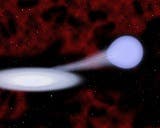Supernovae are highly energetic events caused by the explosion of stars that are at times so bright they can outshine whole galaxies. These are thought to occur in two varieties, but a recently published paper has a described a third type of supernova, one that’s fainter than the other two and distinguishes itself by the fact that its parent star isn’t necessarily obliterated in the supernova event.
The two main types of supernovae discovered thus far are core-collapse and Type Ia supernovae. The first is the brightest and most energetic typically occurring in the wake of the explosion of a star 10 to 100 times as massive as our sun. Type Ia supernovae on the other hand surface when white dwarf stars are destroyed – faint star remnants that have passed their lifetime and are out of fuel.

The newly discovered category of supernovae is called a Type Iax and essentially encompasses tiny supernovae that are fainter than Type Ia supernovae and which, as the latter, come from exploding white dwarfs. The main difference between the two lies in the fact that while a Type Ia will completely obliterate the generating white dwarf, a Type Iax won’t necessarily cause this.
The team of astronomers at Carnegie Institute for Science, led by Max Stritzinger, has identified so far 25 examples of the new type of supernova, none of which having been found in elliptical galaxies, typically filled with older stars, suggesting Type Iax supernovae are generated by young star systems. The reason they haven’t been identified until now is because they’re very faint and only recently after a technological barrier was breached could astronomers study them.
Based on their collection of astronomical data, the researchers claim Type Iax supernovae come from binary systems formed out of a white dwarf and a companion star that has lost its outer hydrogen, leaving it helium dominated. The latter becomes thus exposed to the hungry for fuel white dwarf that will feed helium off the normal star.
The exact mechanisms that trigger Type Iax haven’t been identified yet, but the researchers believe it’s possible the outer helium layer ignites first, sending a shock wave into the white dwarf. Just as well, the white dwarf might ignite first due to the influence of the overlying helium shell.
Oddly enough, though newly discovered, it’s believed Type Iax are about a third as common as Type Ia supernovae. “The closer we look, the more ways we find for stars to explode,” the authors note.
The Type Iax supernovae have been reported in a paper published in The Astrophysical Journal.






